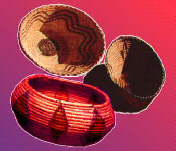|
This information was taken from an original by E. Cooper (?) it is now revised and updated with extra notes The Cahuilla Indians have inhabited the area from Borrego to Riverside for more than 2000
years, an area of about 2,400 square miles.
They are generally referred to as Mountain, Desert and Pass Cahuillas. There are 10
reservations in Southern Ca. Those who settled in what is now Palm Springs are the Agua
Caliente Indians. Other Bands are the Morongo, Los Coyotes, Torres-Martinez, Cabazon and the
Santa Rosa.
Like their Paiute cousins to the north, they are described as hunters and gatherers. Their
language is Uto-Aztecan or Shoshonean stock which is part of the same language family also
shared by the Paiute among others. The men traditionally hunted with bows and arrows, traps,
throwing sticks and clubs. Their prey was desert bighorn sheep, (as can be seen in many
petroglyphs,) deer, antelope, rabbit, and other small mammals.
Women gathered seeds, mesquite beans, pinion, acorns, cactus buds, chia, and (the Agua
Caliente) harvested the seeds of the W. Filifera Palm trees in desert groves near or adjacent to
springs throughout the deserts of Southern California.
There were over 200 plants throughout the area which were gathered for food, medicine and
shelter. Among these the W. Filifera Palm or Desert Fan Palm was used in addition to
cat-tails, devil's claw, juncas and reeds and other grasses for baskets and hukis or wickiups.
The Cahuilla located their camps near water and food sources. It is interesting to note however,
that the Cahuilla have never been known to locate their camps directly within a Palm
grovesurrounding a spring. There are legends that indicate that perhaps the groves were
believed to be haunted, and since owls were frequent nesters in the Palms and perhaps this is of
some significance. It has been suggested and more likely however, that the real reason for not
placing a camp within a Palm grove was because of simple safety concerns since fire and the
Desert Fan Palm do not mix well and lives could easily and quickly be lost in accidental
infernos.
Just as it is supposed regarding the southern Paiute (Moapa bands) to the north, it is thought that
the Cahuilla may have learned to make pottery from their eastern neighbors, the pueblos. This
has also been observed through study of the pueblo type Lost Ruins near Overton NV. It should
be noted however, that some researchers now believe it is highly possible that the ancient
peoples such as those of the Lost City simply overlapped the rise of the later Paiute culture and
that in some cases they may be the same people. (See Nevada State Museum Anthropological
papers Number 5, Richard Shutler Jr. June 1961)
The Cahuilla, as were most tribes of this heritage, were very adept at basket making and usually
used the coiled method for construction.
The first encounter with Europeans was in 1774 when Juan Bautista de Anza was looking for a
trade route between Sonora, Mexico and Monterey, CA. Living so far inland, Cahuillas had
little contact with Spanish soldiers or European civilians and Priests, many of whom saw the
desert as having little or no value but rather a place to avoid. They learned of Mission life
from Indians living close to Missions in San Gabriel and San Diego.
There may have been as many as 10,000 Cahuillas before contact with the Europeans who in
1862 brought a small pox epidemic. Only about 2,500 survived.
To encourage the railroad builders, the U.S. government divided the lands into one mile square
sections, giving the Indians every other section. In 1877 the government established reservation
boundaries which left the Cahuillas only 2\3 of the land they previously considered home.
Perhaps in a bittersweet twist of fortune, the Cahuilla were partially spared the wars and some of
the atrocities which befell most other surrounding Original American communities. But only
because for so long the areas the Cahuilla considered home were of little or no value to the new
white "squatters". This changed of course by the late 1800's and by the 1900's the area was being
hailed by white promoters as a veritable Oasis with clean healthy air and a wonderful winter
climate. Today, Palm Springs and surrounding areas are flooded with People and the very Rich
like to be associated with it. Many of the more mountainous areas however are still largely
devoid of people and it is here that some remaining small bands of Cahuilla carry on with
relative quietness compared to the highly populated areas of the valley. The Agua Caliente band
in Palm Springs collect Park fees for tourists and hikers to see the beautiful natural Palm
Canyon and two other natural springs with hundreds or even thousands of native Desert Fan
Palms which are located on their native homelands.
Today there are about 290 registered Cahuillas as recorded by the tribal headquarters.
(Below is a basket typical of Cahuilla palm fiber construction earlier in this century.)
This is an unofficial site of the agua Caliente band of Cahuilla. If you would like more information visit the following site regarding the agua Caliente Band of Cahuilla : Click Below:The Palm Springs Indians/Agua-Caliente-CahuillaGo back to the Desert Fan Palms in Nevada page: |
